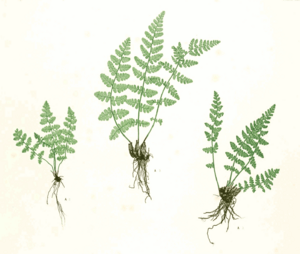Oblong woodsia facts for kids
Quick facts for kids Oblong woodsia |
|
|---|---|
 |
|
| Conservation status | |
| Scientific classification | |
| Genus: |
Woodsia
|
| Species: |
ilvensis
|
| Synonyms | |
|
Acrostichum ilvense L. (basionym) |
|
The Oblong woodsia (scientific name: Woodsia ilvensis) is a type of fern. You can find it growing in North America and the northern parts of Eurasia. People also call it the rusty woodsia or rusty cliff fern. This fern usually grows on sunny, open cliffs and rocky slopes. It likes thin, dry, and slightly acidic soil.
Where Oblong Woodsia Lives
The Oblong woodsia is found all around the northern parts of the world, which is called a circumpolar distribution. It grows a lot in places like Scandinavia, the Ural and Altai mountains, and the eastern United States. You can also spot it in Japan, Alaska, Canada, and along the coast of Greenland. It's also found in different parts of Europe, including the Alps.
In the United States, this fern is considered "Threatened" or "Endangered" in states like Illinois, Iowa, and Maryland. This means there aren't many of them left in these areas. It's thought to be completely gone from Ohio. However, it's the most common type of Woodsia fern found in the US, and it also grows in West Virginia and North Carolina.
In the United Kingdom, the Oblong woodsia is only found in a few specific places. These include Angus and the Moffat Hills in Scotland, northern Wales, and Teesdale and the Lake District in England. There are fewer than 90 groups of these ferns left in the wild across the whole UK. Because it's so rare there, it's considered "Endangered" in the UK. To protect it, the Oblong woodsia became a protected species in the UK in 1975.
Discovery and How We Identify It
The Oblong woodsia was first recognized as its own unique plant in 1785. A scientist named Bolton wrote about it in his book Filices Britannica. Before this, people often confused it with another fern. Bolton helped us tell the difference between Acrostichum ilvense (which is now Oblong woodsia) and Acrostichum alpina (now called Alpine woodsia).
The group of ferns called Woodsia was officially named in 1810 by Robert Brown. He named it after an English plant expert named Joseph Woods. The second part of its scientific name, "Ilvensis", comes from the Latin name for the island of Elba.
The leaves of the Oblong woodsia are usually about 6 inches (15 cm) long and 1 inch (2.5 cm) wide. They have stiff, pointed tips and are divided into about 12 small leaflets that grow almost opposite each other. The underside of the leaves is covered in soft, white, woolly fibers. These fibers later change color and become a rusty brown.
Protecting the Oblong Woodsia
During the mid-1800s, in the Victorian era, many people became very interested in collecting ferns. This hobby was so popular it was even called "pteridomania" or "fern-fever." Unfortunately, this led to a big problem for the Oblong woodsia, especially in the Moffat Hills in Scotland. These hills once had the largest groups of this fern in the UK.
Because of too much collecting, there are now only a few small groups of Oblong woodsia left in the Moffat Hills. Their future is still uncertain. To help protect this special fern, the Royal Botanic Garden Edinburgh has a plan. They want to grow more Oblong woodsia plants in their gardens and store its spores (like seeds for ferns). Their goal is to use these plants and spores to help bring back the fern populations in the wild that have become very small.


